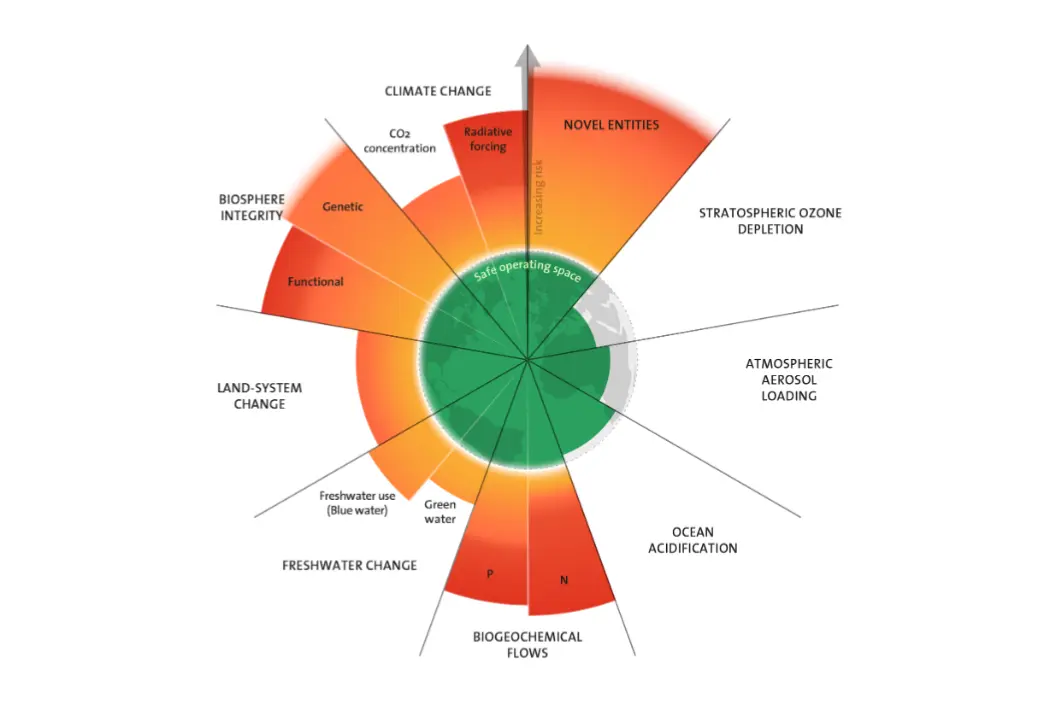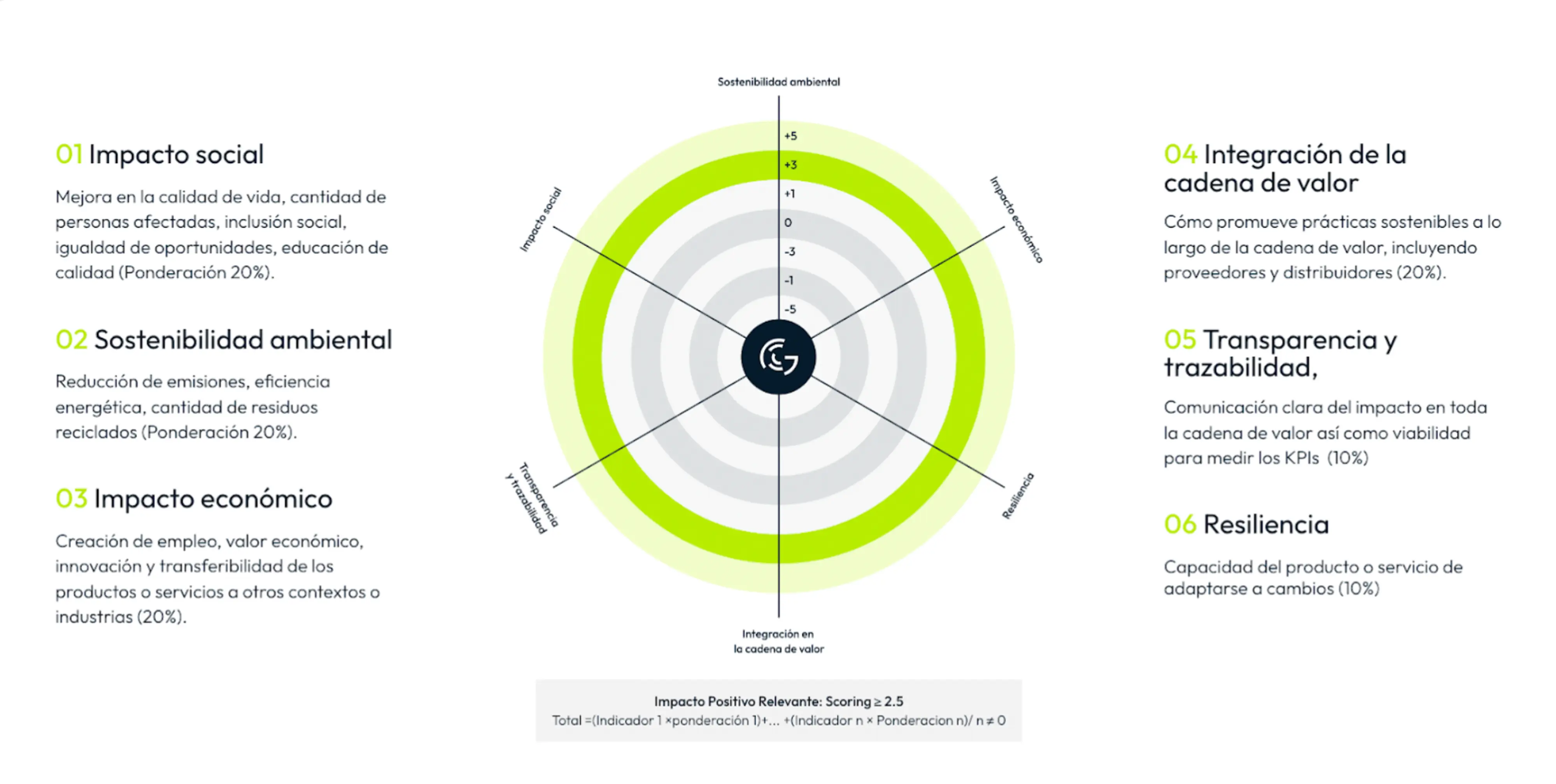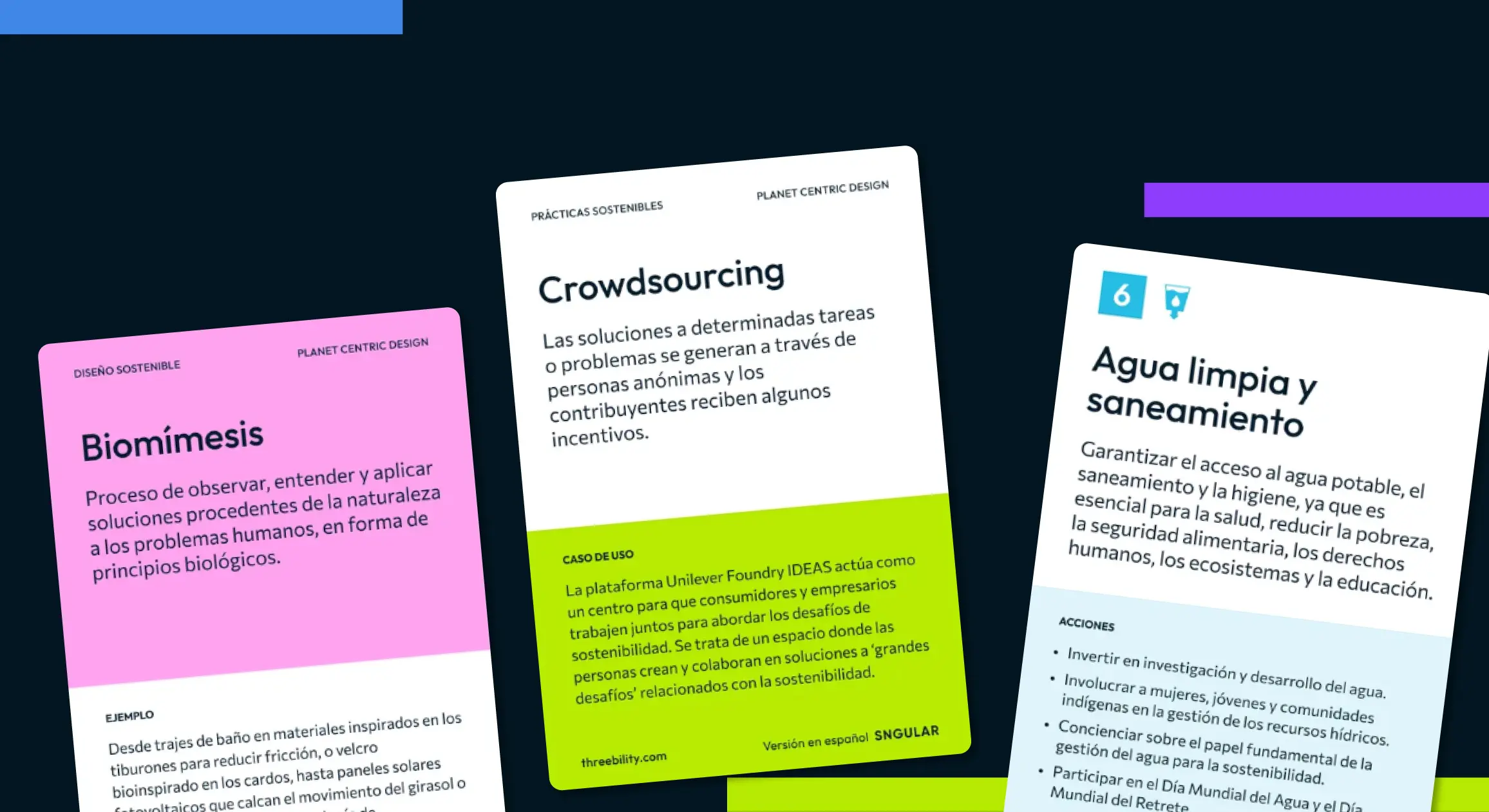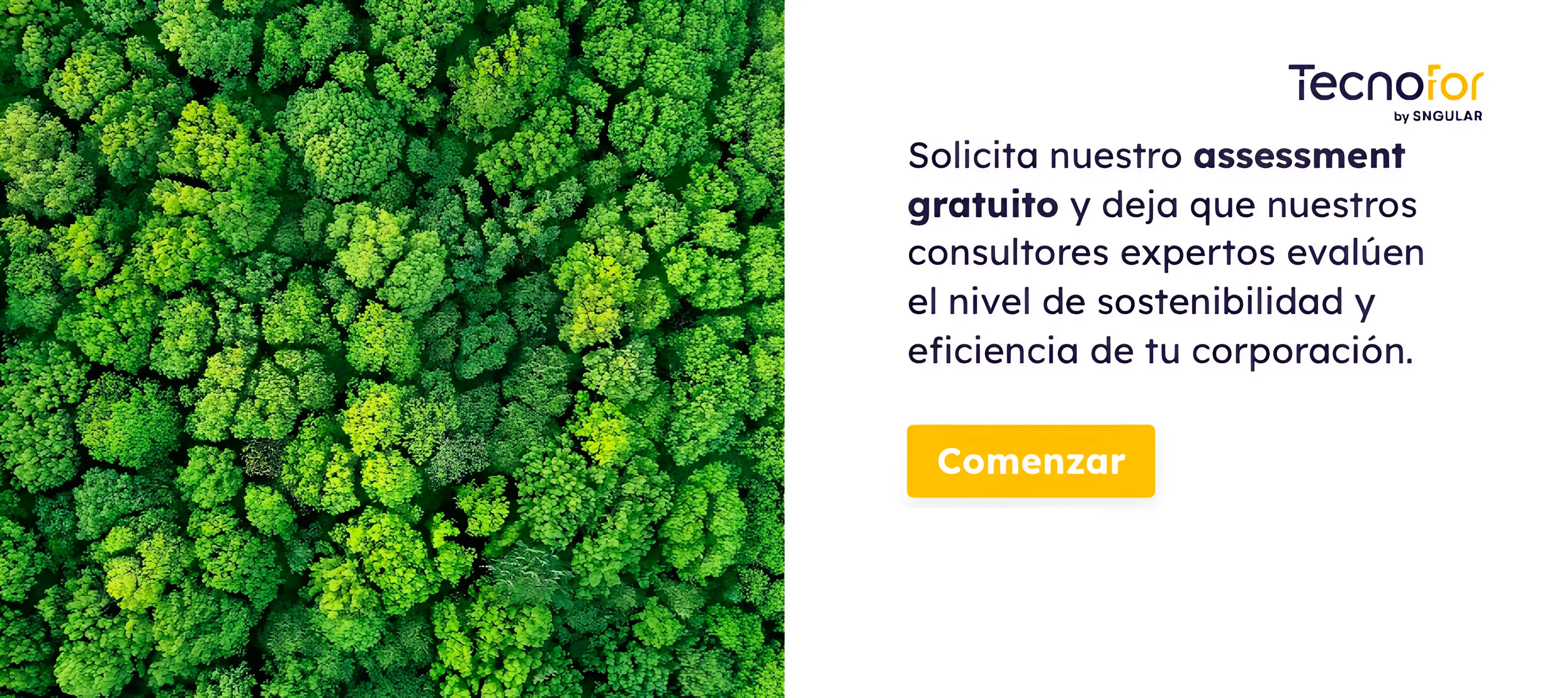
Impact Innovation: How to evaluate and design sustainable digital products
November 5, 2024
Impact innovation: A comprehensive approach to sustainable change
It’s time to move beyond the notion that technology is inherently good or bad based on its use. The impact of any technological innovation depends on the intentionality behind its creation, from conceptualization to every step of its design and development.
Impact Innovation represents an opportunity to redefine how we conceive and develop products and services, generating value that goes far beyond economic benefits. Unlike traditional innovation, which typically focuses on improving efficiency and competitiveness, impact innovation has a broader purpose: it actively seeks to improve people’s lives and protect the natural environment at every stage of design and development. And not only that: a 79% of companies that incorporate impact-driven strategies report greater competitiveness. If you’re not doing it for the planet, do it for the sustainability of your business.

Why nature is now a strategic business topic
Research from the Stockholm Resilience Center on planetary boundaries identifies nine critical areas that support Earth’s stability. Currently, six of these boundaries have been exceeded. This also contributes to increased regulatory pressure.

For this reason, companies integrating ESG principles into their strategies and innovations are reducing their risk and enhancing their resilience to natural challenges, while also creating business value.
In this context, the Corporate Sustainability Reporting Directive (CSRD) gains special relevance. This regulatory framework requires companies to report transparently and comprehensively on their social and environmental impacts. The CSRD promotes accountability in business management, ensuring that sustainability is at the core of all activities. Additionally, this law brings penalties; non-compliance responsibilities are equated to those for financial reporting disclosures. Therefore, it is essential to evaluate, design, and develop digital products that not only are profitable but also meet the expectations of regulators, customers, and society at large.
If you want to learn more about implementing the CSRD and explore technological tools that can optimize the reporting process, you can join our Webinar on Sustainability, AI, and Automation for CSRD. In this session, we will discuss strategies, action plans, and tools for creating reports aligned with this regulation and answer your questions alongside industry experts.
Impact strategy
In an innovation process, we start with a specific challenge to solve, creating solutions prioritized based on criteria relevant to the organization: problem-solving ability, scalability, and time to market are some of the most commonly used factors. In impact innovation, we also evaluate factors ranging from the resources the product consumes in its development and operation to the social and environmental effects it generates.
When maximizing positive impact is one of our strategic objectives, it is essential to be clear about our starting point and where we want to go. That is:
- Define a baseline that includes data describing conditions before implementing changes:
- Use of natural resources: Quantify resources consumed.
- Ecosystem effects: Assess how the product affects the natural environment.
- Pollution: Measure the carbon footprint generated throughout the product's lifecycle.
- Set strategic objectives, including those that address the environmental and social risks and opportunities associated with our economic activity.
At this stage, conducting a competitor analysis and double materiality assessment can be valuable to understand how others design their products and how this, along with environmental factors, could affect our market position.
Identifying impact in digital products is also relevant, even if it seems less obvious. For instance, a study by The Shift Project revealed that one hour of streaming on Netflix generates approximately 36 grams of CO, and another report by Purdue University showed that one hour of video calls produces between 150 and 1,000 grams of CO, depending on video quality and infrastructure used.
Throughout this article, we’ll address this process around a challenge: achieving a profound cultural change in how users perceive and engage with the banking system. This challenge aims to redefine financial value to include social and environmental impact, sustain profitability without losing purpose, and secure user engagement. To that end, together with Abanca, we created B100: a digital bank focused on financial, personal, and environmental well-being.
GAIA Impact Index: Assessing the positive impact of technology
Impact assessment
The GAIA Impact Index, an initiative we developed in collaboration with the University of Valladolid, aims to provide a structured and comprehensive framework for assessing and enhancing the positive impact of technological products and processes. This index focuses on how technology can truly add value in areas such as environmental sustainability, social well-being, and economic growth.

Here, I’ll share the six key areas that make up the GAIA Index, enabling us not only to measure but also to maximize the benefits of our technological solutions.
-
Social impact: A digital product can have a significant effect on social inclusion and equal opportunities. Examples include eliminating fees and offering additional benefits to active customers, providing accessibility options for visually or hearing-impaired clients, microcredit options, an educational platform for financial literacy, and support for entrepreneurs through guidance or special loans.
-
Environmental sustainability: This aspect assesses impact in terms of emission reduction, energy efficiency, and resource recycling. Digital products can be optimized by migrating to renewable energy servers, simplifying code to reduce resource usage, or promoting recycling and reuse of banking devices.
-
Economic impact: In addition to environmental and social sustainability, digital products can positively influence job creation and innovation. For example, knowledge transfer in open-source software can be scaled to new sectors, hiring local talent and skill development through training, and expanding financial services to sectors with lower financial inclusion.
-
Value chain integration: This includes not only the company developing the digital product but also its hardware, infrastructure, and service providers. For instance, digital banks could prioritize cloud providers using 100% renewable energy or employ blockchain traceability to ensure transparency in processes.
-
Governance and traceability: Having clear metrics to measure the impact of technological and process decisions, along with transparency policies and a clear governance structure, is fundamental—especially as reporting and auditing become mandatory.
-
Viability and resilience: Digital products must be able to adapt to technological and regulatory changes. Implementing a flexible, modular, and efficient architecture, automating risk identification and management in regulatory and cybersecurity areas, and stress-testing for resilience under demand peaks are essential for the long-term sustainability of digital banks.
Identification and prioritization of initiatives or features
The GAIA index not only provides an impact scoring based on the key characteristics of a product or company, but it also helps define features or attributes for a new product within the six impact areas. Once these initiatives are identified, we can move towards prioritizing them to maximize value and alignment with strategic goals.
1. Identification of critical areas
Starting from the initial impact assessment or defining various initiatives, we pinpoint areas with the highest emissions and risks using a materiality matrix. This matrix helps visualize the impact of different issues on the business and their relevance for stakeholders, such as employees, customers, regulators, and society at large. To evaluate and prioritize these areas, three key criteria can be considered: environmental efficiency improvements, cost impact, and value generated for customers and the business. For instance, B100’s use of Google Cloud data centers powered by 100% renewable energy, along with optimized infrastructure and code, reduced its environmental impact by 25% compared to the industry average. Additionally, this efficiency had a positive cost impact due to reduced cloud consumption, benefiting customers as well.
2. Prioritization of initiatives
Initiatives with the highest impact and feasibility in alignment with our strategic objectives are prioritized. While the financial sector often focuses on incremental improvements, Abanca’s B100 placed sustainability and incentives for active customers at the core of its offering. The goal is to prioritize the top 20% of initiatives, which yield 80% of the results. For example, once Elon Musk recognized the importance of winning Pennsylvania to sway the U.S. election outcome, he focused his efforts there until he achieved the desired shift.
3. Implementation of improvements
Once defined, innovation and transformation methodologies are applied to implement improvements that promote differentiation. These may include more efficient cloud infrastructure use through autoscaling, deactivation of inactive resources, use of reserved instances, resource circularity, and data storage optimization.mprovements
4. Continuous monitoring and adjustment
It’s essential to measure and continuously monitor the effectiveness of changes in real-time, adjusting strategies as necessary.
To enable a quick analysis of your company’s sustainability and energy efficiency maturity, SNGULAR has developed a self-assessment tool that provides an initial diagnostic to help identify strengths and areas for improvement.
For a quick analysis of your company’s sustainability, energy efficiency, and resource maturity, SNGULAR has created a self-assessment tool that offers an overview to help identify strong points and areas for improvement.
Conceptualization and design of sustainable digital products
How can we design or redefine a product based on strategic goals and identified high-impact areas?
B100, a 100% digital bank developed from scratch for our client Abanca, was born with the purpose of reshaping the banking industry through the concept of “healthy banking,” built around three core pillars: financial health, personal health, and planetary health. As Jorge Mahía, Executive Director of B100, points out: “B100 is born with a purpose from day one: to promote a healthy and sustainable lifestyle.”
The realization of this concept is rooted in the principles of Tim Brown and David Kelley's Design Thinking, alongside Eric Ries’ Lean Startup methodology. This agile, iterative approach enables us to gather customer feedback from the earliest stages, collecting real-world data and insights before fully committing to product development.
To meet sustainability standards, we used the Planet-Centric Design methodology. This approach aims to minimize negative impact while attracting new customers through sustainable innovations. The first step was to set a series of goals and impact criteria, as well as to conduct thorough research to understand market trends, customer needs, motivations, and environmental constraints. To this end, we defined the concept of sustainability and how to integrate it into an appealing financial proposal. Through qualitative and quantitative research methods, we identified the needs of potential customers via interviews, surveys, and focus groups.
As a result, we designed a digital app focused on the planet and people, promoting sustainability and financial health. B100 offers financial benefits to customers who maintain a healthy and active lifestyle, waiving fees and providing an attractive interest rate with better terms than those for customers who don’t. Additionally, a portion of the proceeds from card payments goes to the NGO Gravity Wave, which is dedicated to ocean plastic cleanup.

The B100 project was developed with efficiency as a guiding principle, achieving a reduced digital footprint. The result is an attractive, user-friendly app that provides all the functionalities of a cutting-edge digital bank, with a sustainability-oriented design system and features that help users reach their savings goals. If you want to learn more about the B100 project, you can see it here.
The B100 project inspired us to develop design tools focused on sustainability, such as our Planet Centric Design Cards, which foster awareness and responsibility when conceptualizing products and services.

Ultimately, impact innovation redefines digital product creation so that they are not only profitable but also socially responsible and environmentally sustainable. Cases like B100 demonstrate how “healthy banking” can differentiate itself by integrating sustainability and social value, meeting the expectations of both customers and regulators.
Our latest news
Interested in learning more about how we are constantly adapting to the new digital frontier?

Tech Insight
January 13, 2025
How to bring your application closer to everyone

Tech Insight
December 19, 2024
Contract Testing with Pact - The final cheetsheet

Insight
December 10, 2024
Groundbreaking technologies today that will reshape the innovation landscape in 2025

Insight
December 3, 2024
Sustainable Development: Minimizing Digital Footprint and Optimizing Consumption

